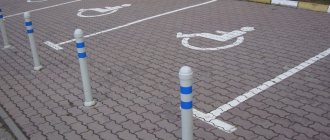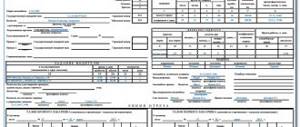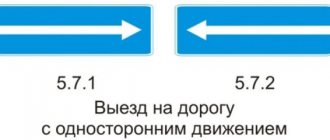Just ten years ago there were very few cars with the “Disabled” sign on Russian roads. But the introduction of paid parking, the emergence of benefits for certain categories of citizens (in particular for the disabled), as well as separate parking spaces, led to the appearance of many cars with a characteristic distinctive sign - a wheelchair on a yellow background. The paradox of the situation was that there was not a single single document in the country regulating the appearance of the “Disabled” sign on a car, except for the indication in the Road Traffic Rules that vehicles driven by disabled people of groups I and II, transporting such disabled people or disabled children, an identification sign “Disabled” may be installed. You could buy it in any store.
The first law that addressed this topic appeared in 2011. Article 12.5 of the Code of Administrative Offenses was supplemented with clause 4.1, which prescribed a fine of 5,000 rubles for illegal installation. Liability was introduced, but no explanation was given as to how to legally install and use the sign. Only in February 2016, amendments to the traffic rules were adopted, obliging disabled drivers or persons transporting people with disabilities to carry certificates confirming their physical condition.
Finally, on September 4, 2021, Order of the Ministry of Labor No. 443n came into force, approving the “Procedure for issuing the identification badge “Disabled” for individual use.” Previously, on June 14, by a government resolution, this department was given the opportunity to exercise powers in this matter, since even the drafter of such a “Procedure” had not been determined by law before.
Let's look at how the country's more than eight million officially registered disabled people can now obtain a car placard that confirms their status and provides certain benefits.
Who can use such a sign?
This is the most incomprehensible and controversial point of the entire “Order”. In order to understand all the ambiguous and unclear points, it is better to quote it in full:
“This Procedure determines the rules for issuing the identification badge “Disabled” for individual use, confirming the right to free parking for vehicles driven by disabled people of groups I, II, as well as disabled people of group III in the manner established by the Government of the Russian Federation, and vehicles carrying such disabled people and (or) disabled children.”
What does "individual use" mean? An individual is always one person. It is unlikely that the rule-makers had in mind the fact that a disabled person should be alone in the car. After all, quite often people with disabilities cannot move unaccompanied, even if they drive a car themselves. And “Order” also has no right to reject the right to commercial use, since every person can use his property as he pleases within the framework of the law. The owner can also earn money using his property, which is a car. So that's the wording.
Order approving the Procedure for issuing the Disabled Person identification badge
Today, the “Disabled” sign can be purchased on the open market for 100-200 rubles. Some unscrupulous drivers actively take advantage of this, registering their cars as disabled people and then taking advantage of free parking. This is confirmed by the statistics of the State Public Institution “Administrator of the Moscow Parking Space”.
As of 2021, the annual volume of issuing parking permits for disabled people has tripled in the capital. At the same time, the number of people with disabilities in the city has decreased. Four years ago there were 1.19 million people registered, and a year ago - 1.1 million.
Due to the abuses that take place, sometimes a real disabled person has nowhere to park. Order No. 443N “On approval of the Procedure for issuing the identification badge “Disabled” for individual use” appeared in the course of amending the law “On Social Protection of Disabled Persons”.
What about free parking?
The addition about the use of “confirming the right to free parking” also raises questions. After all, it essentially limits the benefits of the “Disabled” sign to paid parking only. According to the Traffic Rules, a disabled person’s car can pass under signs 3.2 (Traffic is prohibited), 3.3 (Motor vehicles are prohibited) and stop in the coverage area of signs 3.28 (Parking is prohibited), 3.29/30 (Parking is prohibited on odd/even days of the month) . Since traffic regulations have greater force than the “Order” approved by the department, this restriction - only for paid parking - looks absolutely meaningless.
In addition to the right to park for free, there are also special spaces for disabled people that ordinary motorists cannot use. For parking in a specially designated slot for disabled people, you can get a fine of 5,000 rubles or then have to look for a towed car.
Fine
However, one should not neglect the loyalty of traffic inspectors to cars with the “Disabled” sign. If the owner of the sticker is not in the car, the traffic police officer will issue a report for unlawful use of privileges. Checking the documents of the driver or passengers, which reveals the lack of the right to use the “Disabled” sign, allows the driver of the car to be charged under an administrative offense and a monetary penalty of five thousand rubles .
When the sign in question is on the car, the driver or passenger must present to the traffic inspector a document that is the basis for using the sign. Such papers should always be present to a person with disabilities.
You can confirm your right to use benefits using a pension certificate, which contains a note about the disability group received. A certificate containing the conclusion of a medical and social examination is also suitable for a traffic police officer.
How to get a badge?
To obtain a badge, you need to contact the Bureau of Medical and Social Expertise , which also issues basic certificates of disability. This may be a branch (you need to go there first), the main bureau (if problems arose in the first instance - a refusal was received or additional examinations are required) and, most importantly, the Federal Bureau (issuing signs in particularly difficult cases of establishing disability). The badge can be obtained both at the place of primary registration and at the place of stay.
The main document is an application for obtaining a badge . In addition to the application itself, it must indicate the full name of the disabled person, residential address and insurance policy number. You will also need to provide an identity document and a certificate of disability . An application and the same package of documents can be submitted on behalf of the legal representative of a disabled person.
But you will have to wait a month for the sign to be issued from the date of registration of the application. It is not clear why it takes so long: in Moscow, a preferential parking permit is issued in 10 days, and the bureau that itself issued the disability certificate does not need to check its authenticity. Perhaps these 30 days will be spent on making the sign itself. Receiving the finished sign will only take a day.
If the sign is lost or has become unusable, you can get a duplicate by submitting the same package of documents. When changing the region of stay in a new place, a disabled person will have to receive a new badge according to the same rules. The procedure does not provide for any fee for issuing a “Disabled Person” badge.
The “Disabled” car sign will no longer be tied to the car
The new badge will become individual, and it can be received by the disabled person himself or his legal representative at a medical and social examination institution. Among other things, now these signs will become personal
Photo: Vyacheslav Prokofiev/TASS
Updated at 16:44
On Tuesday, September 4, new rules for issuing a “Disabled Person” car sign came into effect. According to the order of the Russian Ministry of Labor, this sign will be issued and issued by the Bureau of Medical and Social Expertise. It will no longer be available for free sale.
Each sign will have an identification number; it will also indicate: last name, first name, patronymic of the disabled person, date of birth, details of the disability document and group. The details were told to Business FM by the head and chief expert of the Federal Bureau of Medical and Social Expertise, Mikhail Dymochka:
Mikhail Dymochka head, chief expert of the Federal Bureau of Medical and Social Expertise “What kind of car it is is not of fundamental importance, because the sign is issued to the person, if it is a disabled adult, or, if it is a child, then to a child with the established category - disabled child. Thus, any vehicle that transports it can take advantage of this benefit. In addition, it is ensured that data on the issuance of the mark is entered into the state information system, which is protected accordingly. No one from the outside can make changes there. This data can be verified through the federal registry of disabled people. If a disabled person comes to the store, these signs remain in the car, and they ensure that this benefit is taken into account. We went to the store, came back and went home, there are no questions here. If an acquaintance just dropped him off or gave a ride somewhere to a disabled person, then the disabled person took the signs with him, and the acquaintance left.”
Will the new rules for obtaining a “Disabled Person” sign help rid parking lots of those who now park with a “yellow sticker” without having the right to do so? While the result is difficult to predict, says Sergei Kanaev, head of the Federation of Car Owners of Russia:
Sergey Kanaev, head of the public movement “Federation of Car Owners of Russia” “From the point of view of prevention and initiatives in this case, I think that everything has been done very wisely, because disabled people cannot find a place for themselves, and as a result, parked cars with signs” are parked in their places. Disabled person". It is also very difficult to fine them. There is an attempt to explain to people that we are trying to link the “Disabled” sign to a system that, in addition to places for the disabled, would provide such opportunities for the disabled. I think this is absolutely normal. Let’s see how this will be implemented, then we can already evaluate whether this really produced results and provided an advantage to people with disabilities, or whether this is just another scheme that does not work at all.”
The new requirements for obtaining the “Disabled Person” badge and the conditions for its use are much more convenient than those that were in effect previously. Previously, special rules were assigned to the specific car that a disabled person drives. Ekaterina Shalmina says:
“I changed my car, my permit was valid for a year, the same as the duration of my disability. And I was faced with the fact that I had to completely re-register, roughly speaking, this is an invalid permit. It’s incredibly inconvenient that it needs to be registered specifically for a car, because I can really take a child in any car, and the fact that a particular car can park under a sign for a disabled person is inconvenient. Because this would be the case, for example, in a carsharing car, in theory, if I have a disabled person with me, I can stand under this sign. In the car of a relative or friend, who has me included, for example, in the compulsory motor liability insurance policy, I can also take my child and will also have these rights.”
At the same time, some experts do not rule out that new signs will also appear over time among those who should not own them. At the same time, identifying the offender will not be easy, since if the car is parked for the whole day, then it is unlikely that the inspector will be willing to wait that long to find out whether a disabled person will actually ride in the car.
Recently in Dagestan it became known about massive cases of issuing fictitious disabilities. Over the past year, 300 people were recognized as disabled in the republic. A criminal case was opened against the head of the Main Bureau of Medical and Social Expertise, Magomed Makhachev, under five articles, and the entire leadership of the bureau was removed from their positions. According to investigators, damage to the state over the past year exceeded 20 million rubles.
Add BFM.ru to your news sources?
How does an issued sign differ from one purchased in a store?
Just as before, the sign will comply with the accepted GOST standards: size 15x15 cm, yellow background color, black symbol. But now on the front side of the plate the following will appear: the owner’s data (entered by hand or in print), the badge number, the expiration date of the disability (then the badge will expire; if the expiration date is not specified, the badge is valid indefinitely) and the region of issue. On the back will be placed: the full name of the disabled person, date of birth, certificate number, validity period, disability group and date of issue of the badge.
What does the new Disabled sign look like?
There are no innovations in the size and color of the sticker. Simply, on the front side, information about the owner - a disabled person (can be entered manually or printed), the registration number of the sign, the region of receipt, and the validity period coinciding with the expiration date of the disability - are now written down. If a specific number is not indicated, then the plate has no expiration date. Its reverse side contains the citizen’s full name, information about his date of birth, the number of the medical report, the assigned group, the deadline for receiving and validity of the plate.
To prevent unauthorized persons from obtaining personal data, you can attach a piece of paper under the back.
Advantages of the new sign
One of the advantages of the adopted “Order” is that the “Disabled” sign is not tied to a specific car. Now the sign is valid when a person with disabilities is inside the car. Thus, the owner can use any vehicle for transportation, including a taxi. You just need to place the signs under the front and rear windows of the vehicle. The same applies to persons transporting disabled people or disabled children.
But we must not forget that if there is no disabled person in the car, the signs must be removed. Otherwise, you face the same punishment for illegal use. An invalid sign will not protect against all fines and sanctions that apply to ordinary cars for violating traffic rules.
What does the Disabled sign give to its owner?
The Disabled person sign allows you to park for free in spaces for disabled people located closest to the entrances to shopping centers and other public places. If an ordinary car without identification marks is parked in such a place, then it can be evacuated to an impound lot and its owner fined 5 thousand rubles.
Disabled people of groups I and II, and in some cases, disabled people of group III with a confirmed disability can hang a corresponding sign on their car. Even if a disabled person does not own a vehicle, he can still receive a sign.
The text of the order does not link the received identification mark to a specific vehicle, but only to a specific person. A disabled person can carry the sign with him and attach it to any car that he will use for transportation. This is especially true in cases of transporting disabled children.
Do you need to rush to receive it?
On the one hand, it is better not to hesitate. After all, the adopted “Order” is a legal method required by the Administrative Code. But, in any case, from September 4, all disabled drivers will be violators for at least a month - and this is the period during which they are required to issue a new sign - even if they submit an application and all other necessary documents on the day the new “Procedure” comes into effect.
On the other hand, the current “Procedure” is a completely separate document, not related to GOSTs, traffic rules, or the same Code of Administrative Offenses, since these laws do not contain references to the Order of the Ministry of Labor, which means that the mandatory execution of this document remains unclear. And the benefits for paid parking in different cities, as well as the rules for obtaining them, vary.
An obvious advantage of the adopted “Procedure for obtaining “Disabled” signs” is the elimination from the streets of those unscrupulous car owners who often resorted to buying a fake disability certificate and, hiding behind yellow signs, violated traffic rules. But there is also a minus: real disabled people will have to make an effort to get these signs. They will once again have to undergo a certain and not entirely simple procedure in order to make their life easier.










